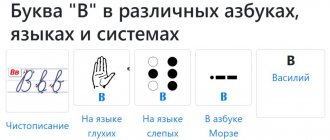How to learn to read faster
People who want to become professionals in their field must work through a huge amount of information. In addition, there are so many interesting books in the world, and I would like to read everything, but I am sorely short of time. There is a way out - learn to read quickly. And this is possible: Napoleon Bonaparte, Honore de Balzac, Albert Einstein, John Kennedy, Maxim Gorky and others read quickly, up to 2 thousand words per minute. For example, Napoleon read one rather voluminous book every morning before breakfast, managing to mark important things in its margins. thoughts for him.
And former American President Theodore Roosevelt, who reads at incredible speed, developed his own method of speed reading, which is now successfully used by those who want to learn it.
It could be argued that reading quickly reduces reading comprehension and retention. But practice shows that the opposite is true: with normal reading, approximately half of the information is absorbed, while with speed reading, 70-80%.
Why does this happen? Because fast reading requires more concentration than normal reading, during which we read less carefully. We have parallel thoughts: we think about current affairs, for example, that it’s time to turn off the refrigerator, about the upcoming vacation, or our thoughts return to past events. It is not surprising that reading progress is slow, and new information is poorly remembered.
You can master speed reading methods at special trainings: 5 lessons of 3.5-4 hours are enough. Their advantage lies not only in the fact that the classes are taught by specialists, but also in the fact that, firstly, the person who paid for the training is unlikely to want to voluntarily skip classes. Secondly, teachers form pairs of students, making classes more effective. Thus, the one who risks missing class will let his partner down - the obligation to him will serve as an additional incentive not to shy away from classes.
You can learn to speed read on your own. To do this, you just need a great desire, faith in the result and daily training. And if many people have the desire, then with faith it will be more difficult. Let's remember how children learn to ride a bicycle: those who think they will fall actually fall; those who are sure that they will go straight away somehow miraculously keep their balance and go. We believe that we can do it!
As for training, we do special exercises every day for 30-40 minutes for 21 days. Psychologists believe that it takes so long to get rid of an old habit and instill a new one.
For exercises, you need to choose a convenient time and place so that nothing distracts you from reading. It is useless to do this, for example, in the subway, where it is impossible to concentrate.
Reading "diagonally"
Under this collective name, several speed reading techniques can be combined: firstly, reading “zigzags” (zigzag movements of the gaze along the page), and secondly, “covering” the entire page, “at one glance.”
According to speed readers who practice these techniques, this approach allows them to read using their peripheral vision. What scientists say: reading this way is hardly possible. The whole problem is in that very peripheral vision. Scientists prove that peripheral vision (with all its advantages) does not allow us to adequately perceive and recognize text - in such conditions we simply cannot read it.
We can only read text that falls within the area of our foveal vision (central 1.5–2° visual field): for comparison, our thumb falls approximately into this area if we extend our arm in front of us. Therefore, the human eye cannot read a paragraph or even an entire page - you simply will not see the text.
When “reading diagonally,” our gaze picks out individual words or phrases, which does not allow us to read fully. However, using this approach, we can, for example, get some idea of the material if we have already read it at some point and the text has not been changed since then
.
Verdict
: physiologically this type of reading is impossible.
You can read slightly faster than 500 words per minute, but you are limited by the capabilities of your eyes and the anatomy of your retina.
To understand text, you need to move your eyes so that your foveal vision is in the area [of the page] you want to focus on. Outside this area, visual acuity is noticeably lower - you cannot distinguish words and text far beyond the central field of vision. This is a factor that limits the speed of reading and information processing by the brain - Keith Rayner, one of the most famous reading researchers (worked at the University of Massachusetts at Amherst), book “Eye Movements and Information Processing in Reading”
Popular questions about speed reading
Speed reading is shrouded in various myths and speculations. I have prepared answers to the most popular questions related to it.
- Will I be able to read normally after I master speed reading?
Yes, sure. The skill of ordinary line-by-line reading will not go away. As before, you can enjoy your favorite literature, savoring every word. And swallow business and educational texts effortlessly.
- At what age can you start learning to speed read?
There is no clear answer to this question. Some experts do not recommend training until the age of 14, while others advise starting as early as 7–8. In any case, the child must develop the skill of conscious reading and develop a good line-by-line reading speed. The exercises from our article are suitable for children from 14 years of age. For younger ages, others are used.
- Do you need any special skills to master speed reading?
Apart from the ability to read, no other skills are required. There is nothing difficult about speed reading. This is just repeated practice of special techniques and the development of certain habits.
- Does the skill of speed reading remain with a person forever?
The situation here is the same as with other skills. If you use them regularly or at least refresh your memory, they will serve you for the rest of your life.
- Is it possible to use speed reading to read a foreign language?
Undoubtedly. Provided you have good command of this language.
Reading without stopping
Another speed reading strategy involves reading without stopping.
In order to understand how it differs from regular reading, you will have to remember what we talked about in the first part: our “standard” reading is a discrete process. We fixate on a certain group of words, then with a jerky movement we move our gaze to another group, and so on. After several jumps (or saccades), we take a short pause (during which the brain gets an additional opportunity to process what we read). These regular pauses take between a quarter and half a second - and speed reading without stopping is aimed at suppressing them. However, not everything is so simple: in this way you not only save time, but also do not give yourself the opportunity to better understand and remember what you read. Moreover, it is not so easy to completely suppress the desire to “give yourself a break” - most likely, you will still have such pauses (albeit less often), but the quality of your reading comprehension will still deteriorate.
Verdict
: physically such a reading is quite possible. The only problem is the quality of perception of the text. Some readers of our first part differentiated between “reading with retelling” and “reading without retelling” and it is no coincidence that in order to retell a text read, it is important not to just skim over the lines “in one breath.”
Syllable table
The syllable table helps to train reading at any age. Below is a simple table in Russian.
| A | ABOUT | U | E | AND | |
| B | BA | BO | BOO | BE | BI |
| IN | VA | IN | VU | BE | IN AND |
| G | GA | GO | GU | GE | GI |
| D | YES | BEFORE | DU | DE | DI |
| Z | BEHIND | ZO | memory | WE | ZI |
To improve your skill, read out loud all the rows of the table to the right and left. Gradually speed up your reading pace. Then you can move on to syllables consisting of 2 consonants and 1 vowel.
| A | ABOUT | U | E | AND | |
| NS | NSA | NSO | NSO | NSE | NSI |
| MK | MKA | MKO | MKU | MKE | MKI |
| WB | VBA | UBO | Wetland | VBE | nosocomial infection |
| ETC | PRA | PRO | PRU | PRE | AT |
| ST | STA | ONE HUNDRED | STU | CTE | STI |
The training technique is the same here. Try to reach your maximum reading pace. It is necessary to read aloud to an adult in order to develop rapid reading.
A child of 7 years old can also be given these syllable tables when learning to read. This will be a kind of stimulation for reading for his brain and visual analyzer.
Using this technique, already at the age of 10 the child will be different from his peers. After all, at this age, children’s brains are especially plastic and receptive to educational programs. It’s us adults who need to think about how to develop memory and attention in order to work more efficiently.
Suppression of subvocalization
Subvocalization is the “little voice in our head” that sounds when we read text.
Subvocalization or pronunciation also takes up precious time, which speed readers save. In some cases, such pronunciation leads to the fact that the speed of silent reading is equal to the speed of reading aloud. Therefore, many speed reading techniques teach you to suppress the desire to say the material you read to yourself and help you tune in to “reading with your eyes.” The problem here is that subvocalization is an important element of text recognition, and by suppressing this desire, we begin to understand what we read worse:
You can practice and your reading speed will probably improve, but if you read too quickly, you will no longer understand the text.
Getting rid of subvocalization is used in most speed reading techniques. Research [, ] shows that if the text is sufficiently complex, it becomes impossible to understand. – Keith Rayner, ibid.
Moreover, both Rayner and Ronald Carver (another speed reading researcher and professor of education and psychology at the University of Missouri in Kansas City) have shown in their studies that it is impossible to completely get rid of pronunciation of the text - even those who read at a speed of 720 use subvocalization words per minute, and those who skim the text (they pronounce key words).
This was proven as follows: electromagnetic sensors were connected to the subjects’ throats, which recorded weak nerve impulses sent to the muscles. As a result, it turned out that even those who claim that they do not do this at all pronounce the text - our brain simply cannot do without subvocalization.
This internal voice or “subvocal speech” even became the subject of research by NASA - they wanted to understand whether this feature could be used to give “silent commands”:
Biological signals arise when reading or internal dialogue - regardless of whether the movement of the lips and facial muscles is recorded.
A person using subvocalization thinks of some words and says them to himself so quietly that it cannot be heard, but the tongue and vocal cords still receive speech signals from the brain. – Chuck Jorgensen, Subvocal Recording System Team Leader, NASA
By the way, speed reading champions do not necessarily have to speak or read out loud quickly, they simply have a larger “internal vocabulary of easily recognized words.”
We pronounce unfamiliar words to ourselves more slowly, words that are already in our internal dictionary faster. Verdict
: It is impossible to completely get rid of subvocalization. Moreover, in order to read faster, taking into account the pronunciation of words, it is useful to first “learn to read more slowly” - to expand the internal vocabulary of terms, carefully studying new and unfamiliar words, so that it is easier to pronounce them when encountering them again.
We develop speed reading with workbooks for adults and children
Here's the thing. We wrote, which means we wrote articles, we collected the opinions of various experts, we developed tools for testing reading speed, and then we took and structured all the practical information in two workbooks.
Workbooks for developing speed reading in adults and children are the quintessence of the proverb about the fishing rod and fish. Well, about the fact that no one but yourself can teach you how to read quickly.
Strictly speaking, the children's notebook “How to teach a child to read quickly?”
, it’s not really about speed reading, it’s more about basic skills and how to instill in a child a love of learning through literature. It contains more than 30 pages of theoretical material, as well as a maximum of simple and useful exercises that, in an easy and unobtrusive playful way, will help your child plunge into the magical world of reading.
An adult notebook, “Learning to read faster in 6 weeks”
is an expanded version of what you read in this article, also multiplied by practical exercises and approaches. Here we talk more about how to properly train the muscle responsible for speed reading and that in this, as in any other matter, a systematic approach is important to achieve success.
As a bonus, the package includes our brochure “Everything you wanted to know about speed reading, but were afraid to ask.” A bonus because you can get it for free today. For this it is enough:
1.
Take a test to check your reading speed and comprehension.
2.
Leave your email on the results page.
3.
In a few minutes you will receive a letter with this brochure.
The task of the workbooks is to instill in you and your offspring a set of activities that, with a systematic approach focusing on results, will certainly bear fruit. Use and read quickly







